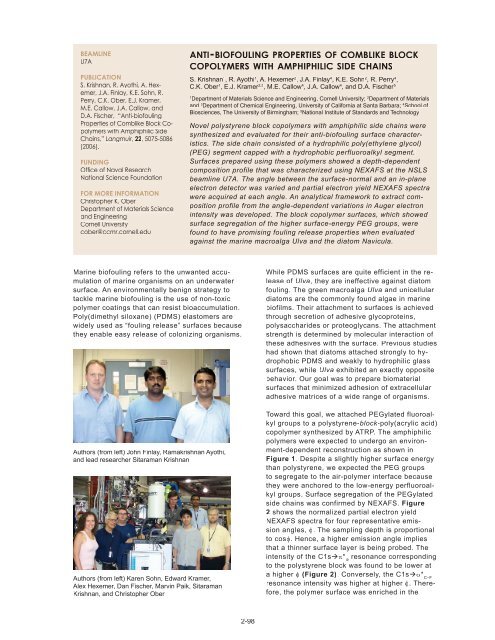NSLS Activity Report 2006 - Brookhaven National Laboratory
NSLS Activity Report 2006 - Brookhaven National Laboratory
NSLS Activity Report 2006 - Brookhaven National Laboratory
You also want an ePaper? Increase the reach of your titles
YUMPU automatically turns print PDFs into web optimized ePapers that Google loves.
BEAMLINE<br />
U7A<br />
PUBLICATION<br />
S. Krishnan, R. Ayothi, A. Hexemer,<br />
J.A. Finlay, K.E. Sohn, R.<br />
Perry, C.K. Ober, E.J. Kramer,<br />
M.E. Callow, J.A. Callow, and<br />
D.A. Fischer, “Anti-biofouling<br />
Properties of Comblike Block Copolymers<br />
with Amphiphilic Side<br />
Chains,” Langmuir, 22, 5075-5086<br />
(<strong>2006</strong>).<br />
FUNDING<br />
Offi ce of Naval Research<br />
<strong>National</strong> Science Foundation<br />
FOR MORE INFORMATION<br />
Christopher K. Ober<br />
Department of Materials Science<br />
and Engineering<br />
Cornell University<br />
cober@ccmr.cornell.edu<br />
Marine biofouling refers to the unwanted accumulation<br />
of marine organisms on an underwater<br />
surface. An environmentally benign strategy to<br />
tackle marine biofouling is the use of non-toxic<br />
polymer coatings that can resist bioaccumulation.<br />
Poly(dimethyl siloxane) (PDMS) elastomers are<br />
widely used as “fouling release” surfaces because<br />
they enable easy release of colonizing organisms.<br />
Authors (from left) John Finlay, Ramakrishnan Ayothi,<br />
and lead researcher Sitaraman Krishnan<br />
Authors (from left) Karen Sohn, Edward Kramer,<br />
Alex Hexemer, Dan Fischer, Marvin Paik, Sitaraman<br />
Krishnan, and Christopher Ober<br />
ANTI-BIOFOULING PROPERTIES OF COMBLIKE BLOCK<br />
COPOLYMERS WITH AMPHIPHILIC SIDE CHAINS<br />
S. Krishnan 1 , R. Ayothi 1 , A. Hexemer 2 , J.A. Finlay 4 , K.E. Sohn 2 , R. Perry 4 ,<br />
C.K. Ober 1 , E.J. Kramer 2,3 , M.E. Callow 4 , J.A. Callow 4 , and D.A. Fischer 5<br />
1 Department of Materials Science and Engineering, Cornell University; 2 Department of Materials<br />
and 3 Department of Chemical Engineering, University of California at Santa Barbara; 4 School of<br />
Biosciences, The University of Birmingham; 5 <strong>National</strong> Institute of Standards and Technology<br />
Novel polystyrene block copolymers with amphiphilic side chains were<br />
synthesized and evaluated for their anti-biofouling surface characteristics.<br />
The side chain consisted of a hydrophilic poly(ethylene glycol)<br />
(PEG) segment capped with a hydrophobic perfluoroalkyl segment.<br />
Surfaces prepared using these polymers showed a depth-dependent<br />
composition profile that was characterized using NEXAFS at the <strong>NSLS</strong><br />
beamline U7A. The angle between the surface-normal and an in-plane<br />
electron detector was varied and partial electron yield NEXAFS spectra<br />
were acquired at each angle. An analytical framework to extract composition<br />
profile from the angle-dependent variations in Auger electron<br />
intensity was developed. The block copolymer surfaces, which showed<br />
surface segregation of the higher surface-energy PEG groups, were<br />
found to have promising fouling release properties when evaluated<br />
against the marine macroalga Ulva and the diatom Navicula.<br />
2-98<br />
While PDMS surfaces are quite efficient in the release<br />
of Ulva, they are ineffective against diatom<br />
fouling. The green macroalga Ulva and unicellular<br />
diatoms are the commonly found algae in marine<br />
biofilms. Their attachment to surfaces is achieved<br />
through secretion of adhesive glycoproteins,<br />
polysaccharides or proteoglycans. The attachment<br />
strength is determined by molecular interaction of<br />
these adhesives with the surface. Previous studies<br />
had shown that diatoms attached strongly to hydrophobic<br />
PDMS and weakly to hydrophilic glass<br />
surfaces, while Ulva exhibited an exactly opposite<br />
behavior. Our goal was to prepare biomaterial<br />
surfaces that minimized adhesion of extracellular<br />
adhesive matrices of a wide range of organisms.<br />
Toward this goal, we attached PEGylated fluoroalkyl<br />
groups to a polystyrene-block-poly(acrylic acid)<br />
copolymer synthesized by ATRP. The amphiphilic<br />
polymers were expected to undergo an environment-dependent<br />
reconstruction as shown in<br />
Figure 1. Despite a slightly higher surface energy<br />
than polystyrene, we expected the PEG groups<br />
to segregate to the air-polymer interface because<br />
they were anchored to the low-energy perfluoroalkyl<br />
groups. Surface segregation of the PEGylated<br />
side chains was confirmed by NEXAFS. Figure<br />
2 shows the normalized partial electron yield<br />
NEXAFS spectra for four representative emission<br />
angles, φ. The sampling depth is proportional<br />
to cosφ. Hence, a higher emission angle implies<br />
that a thinner surface layer is being probed. The<br />
intensity of the C1sàπ* Φ resonance corresponding<br />
to the polystyrene block was found to be lower at<br />
a higher φ (Figure 2). Conversely, the C1sàσ* C–F<br />
resonance intensity was higher at higher φ. Therefore,<br />
the polymer surface was enriched in the

















